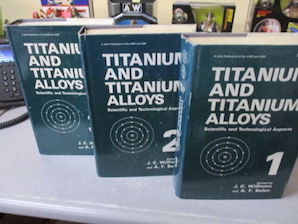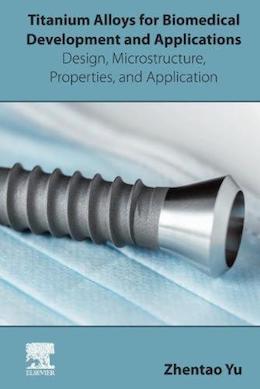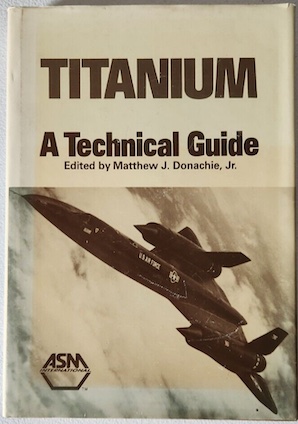
Curated with aloha by
Ted Mooney, P.E. RET

The authoritative public forum
for Metal Finishing 1989-2025

-----
Polishing & Passivation of Titanium
Q. I am looking for a process that can polish the Hip Ball used on hip replacements. The cap is a spherical shape with a 'face' on one side drilled inside to fit the tapered stem. So the cap can only rotate to polish.
Sean Walshmedical hip replacements - Cork, Ireland
2003
A. Not sure of your question. Most medical inplants are processed smooth to eliminate porosity of the surface metal for a couple of reasons. If this is the case, the most common procedure is to use high energy centrifugal force type equipment in a 2 or 3 step process to achieve 12 RMS or finer. If you are asking about a one sided polish, then you must consider some type of wheel system.

AF Kenton
retired business owner - Hatboro, Pennsylvania
2003
A. The medical implants made from cobalt, titanium, stainless steel, Nitinol - are best to electropolish by specially designed high-voltage environmentally safe polishing equipment and electrolyte. In comparison to mechanical polishing this process increases strength of the material surface. You save on time of processing (5-10 minutes), do not need to adjust your equipment to complex shapes, you obtain surgically clean surface without any impurities, and you do not need to passivate surface after polishing.

Anna Berkovich
Russamer Lab
Pittsburgh, Pennsylvania

2003
A. Shaun,
Polishing of all sorts of implants with difficult shapes can be achieved with a six axis robot and polishing wheels.
Tom
- Warwick,UK
April 4, 2013

on AbeBooks
or eBay or
Amazon
(affil links)
by Zhentao Yu

on eBay or
AbeBooks
or Amazon
(affil links)
Q. Dear Sir/Mad.:
I am working with titanium and Ti-6Al-7Nb screw and I want to ask about metal passivation with nitric acid. what is the exact mechanism of this treatment, does it only remove the remnant of metal after machining or it also aids in the formation of the oxide layer on the metal surface? If there is any reference that could be helpful in my research dealing with this matter I will be grateful.
Regards,
Postgraduate student - Penang, Malaysia
2004
Q. A customer is calling out a passivation specification of ASTM A967 less section 12 thru 21. What exactly is section 12 thru 21 eliminating in the process? The material being processed is Titanium 6AL-4V
Jerry Flathers- Santa Ana, California, USA
2005
A. Those sections describe various testing requirements such as frequency of testing and test selection (water immersion, high humidity, salt spray, copper sulphate, etc.). It is curious that your customer would be specifying that passivation be performed according to ASTM A967, which is not appropriate for titanium alloys. ASTM B600 is the proper standard for cleaning and descaling titanium alloys.
Toby PadfieldAutomotive module supplier - Michigan
2005
A. ASTM A967 is often specified for passivation of titanium, although it is a misnomer for sure. What you are removing by "passivation" of titanium is any iron or iron oxide that may have been put on the surface in the fabrication process of the parts. Even though you do not truly passivate the titanium metal itself, you need to remove any iron from the surface so that it does not rust. If you have not put ANY iron or other contaminants on the surface in the fabrication process there should not be a need to "passivate".
Testing of the parts per ASTM A967 would verify whether you have an iron contamination problem.

Lee Kremer
Stellar Solutions, Inc.
McHenry, Illinois

2005
Passivation of heat treated titanium
Q. Hello,
I am passivating heat treated Titanium and would like to know if there is an easier way to break the heat coating prior to alkaline cleaning and Acid passivation. I am currently breaking the surface with scotch-brite pads, but this is very labor intensive. If I don't prep the parts with the scotch-brite, it takes a long time for the acid to react with the oxide layer. Any suggestions would be appreciated.
Thank you in advance.
Metal Finishing - Ottawa, Ontario, Canada
October 21, 2008
A. Change your heat treat process to a vacuum furnace or a reducing atmosphere and you will not get the oxide coating.
Abrasive blasting is a lot quicker and probably cheaper than scotch brite after the initial cost.
- Navarre, Florida
October 22, 2008
tuo Mr. Watts,
We tried as you suggested with the abrasive blasting and the passivation process is working quite nicely now. It is a lot quicker and with a more uniform finish.
Thank you !
- Ottawa, Ontario, Canada
October 30, 2008
How to verify passivation treatment of Ti alloy?
How to check passivation treatment of the Ti alloy?
Mufit Yalcintest engineer - Warner Robins, Georgia
March 31, 2010
A. What were you intending to do with passivation? If it's simply to remove embedded iron one could do a copper sulphate ⇦ this on eBay or Amazon [affil links] verification (reddish metallic copper immersion forms on iron) or salt spray test -- would only need a couple of hours to verify. Titanium is a pretty passive metal as is without passivation! You might want to review a white paper on this site entitled "Why Coat Titanium?" which tells a little more about "coating" titanium.

Milt Stevenson, Jr.
Syracuse, New York
April 4, 2010
Q. So, if "passivating" titanium, would you follow A967 (which apparently is strictly for SS) or would you follow B600 (which refers to it as "cleaning")? Or is there no correct answer- can you "passivate" per the stainless steel spec?
A. Disregard my question. I believe I found my answer. ASTM F86 calls out the "final surface treatment" for metal medical implants (which titanium would fall into). This gives the possibility of "passivation" (misnomer as many apparently consider it) of said metal implants without the use of hydroflouric acid
"Immerse in 20 to 45 volume % nitric acid (specific gravity 1.1197 to 1.285) at room temperature for a minimum of 30 min. For an accelerated process, a 20 to 25% acid solution, heated to 120 to 140 °F (49 to 60 °C), may be used for a minimum of 20 min. (See Specification A967 and Practice ASTM A380
). This treatment provides passivation by surface oxidation and can dissolve certain foreign material that might be present from previous operations"
- New Haven, Connecticut, USA
September 4, 2014
September 19, 2014
A. Steve,
It's a complex issue. A967 is written for stainless steel, so a lot of people might resist accepting it as an authority for nonferrous metals. The recent revision of B600 includes "surface iron removal", which is a way of saying passivation without using the word itself, and procedures copied straight out of A967.
F86, which takes precedence when the parts are implants, includes, among other things:
"5. Cleaning
5.2.3 An acidic cleaning process may be used. For titanium, titanium alloys, and tantalum, some possible cleaning processes may be found in Guide B600."
"6. Final Surface Treatment
6.1 Implants shall be given a final surface treatment before
they are packaged. Anumber of different surface treatments are acceptable, including acid treatment, electropolishing, anodizing, and oxidation. The following surface treatments should not be considered restrictive:"
6.2.1 is what you quoted. I know a number of places that are doing a final passivation with citric acid instead of nitric under the auspices of this clause:
"6.5 If acceptable alternative surface treatments for implants are used, these treatments should be specified in the production procedure documentation."
It really all depends on what your goal is. If you want an electropolished or anodized surface, do that. If the surface is already looking how you want it and you just need to ensure there is no iron contamination on the surface, then "passivate" with nitric or citric acid .

Ray Kremer
Stellar Solutions, Inc.
McHenry, Illinois

Brushing titanium with steel brushes after passivation
Q. A company I know of is using a steel brush with air tools to clean out contaminants in the inner bores of Titanium that have been through passivation. These parts are received to install on assembly; however, during the assembly process they gather FOD to the extent they need to be "cleaned" and the method of cleaning is to use a steel cylinder brush inside the bore. Does this or not negate the passivation certification, and if so, is this explicitly stated in a specification or otherwise documented that this should not be the practice. Please advise. Thank you for your time.
Darryl BrownMetrologist - Indianapolis, Indiana
July 18, 2016
A. As always, we need to carefully define "passivation" here so that everybody is on the same page.
When we talk about dipping stainless steel in acid to passivate, we are removing iron from the surface. Much of the iron is inherent to the alloy, but it can also be contaminant iron introduced from external sources. The remaining iron-depleted surface is high in chromium (and sometimes nickel also) which reacts with air to form stable (passive) metal oxide layer.
Titanium alloys do not contain iron, and therefore the surface does not need an acid treatment to enable formation of a passive metal oxide layer. Unless! If the surface is (or may have been) contaminated with iron from an external source, then that iron can become rust down the road if it is not removed. Since it's fundamentally the same task as passivating stainless steel (removing iron from the surface) we use the same process (nitric or citric acid treatment) and tend to use the same terminology. (Though note that ASTM B600 specifically avoids using the words passivate or passivation even while describing treatments borrowed directly from ASTM A967!)
I hope you can see now that putting it in terms of "undoing the passivation" or "negating the passivation" is not really accurate. For a non-ferrous alloy like titanium, it doesn't really matter what the history is. If you have an iron-free surface, and then contaminate it with iron, you create the possibility of surface rust unless that iron is removed via an acid passivation treatment.
It is extremely destructive to use a carbon steel wire brush on anything that isn't also carbon steel. In your case, even a stainless steel wire brush, regardless of whether or not it sets up a rust problem, would be contaminating your titanium surface with not-titanium material.
Since you did not describe your application or the nature of the foreign object damage that needs to be cleaned, I cannot say what is or isn't potentially a problem for you here.

Ray Kremer
Stellar Solutions, Inc.
McHenry, Illinois

July 22, 2016
![]() The FOD is non-metallic bonding material that nestles in some of the bores as part of the assembly process. This material is quite robust in that in some cases it is the only means of securing the details to the assembly. The assembly is a non-critical flight part that is ITAR controlled. I understand that the "passivation" cannot be undone, but it seems to me that introduction of a steel, whether it is carbon, or stainless might contaminate the fittings to the extent that they no longer would meet the requirement of the customer that the titanium be "passivated" certified at the time that the customer takes possession. Thank you for your expertise in this subject matter and of course, your time.
The FOD is non-metallic bonding material that nestles in some of the bores as part of the assembly process. This material is quite robust in that in some cases it is the only means of securing the details to the assembly. The assembly is a non-critical flight part that is ITAR controlled. I understand that the "passivation" cannot be undone, but it seems to me that introduction of a steel, whether it is carbon, or stainless might contaminate the fittings to the extent that they no longer would meet the requirement of the customer that the titanium be "passivated" certified at the time that the customer takes possession. Thank you for your expertise in this subject matter and of course, your time.
- Indianapolis, Indiana USA
July 23, 2016
Darryl,
Well, again you use the term "undoing the passivation". If you want to think of it that way, you can. It's sort of similar to saying that your pet dog "undid his bath" by rolling in the mud. Most people would just say he "got dirty".
So, if I can make sense of all that properly, this is a titanium part that is getting glued into place, and some of the glue is getting into some holes, so they clean out the holes with a steel wire brush.
I would think this to be one of those ounce of prevention vs pound of cure situations. Could an addition be made to the standard assembly procedure involving some sort of temporary plugs to keep the holes clear and clean? Assuming of course that it would be futile to merely give a dire warning against using too much glue near the holes.

Ray Kremer
Stellar Solutions, Inc.
McHenry, Illinois

July 27, 2016
Please see also --
• Topic 6885 "Problems & Solutions in Passivation of Titanium"
Q, A, or Comment on THIS thread -or- Start a NEW Thread
Disclaimer: It's not possible to fully diagnose a finishing problem or the hazards of an operation via these pages. All information presented is for general reference and does not represent a professional opinion nor the policy of an author's employer. The internet is largely anonymous & unvetted; some names may be fictitious and some recommendations might be harmful.
If you are seeking a product or service related to metal finishing, please check these Directories:
Finishing
Jobshops
Capital
Equipment
Chemicals &
Consumables
Consult'g,
& Software
About/Contact - Privacy Policy - ©1995-2025 finishing.com, Pine Beach, New Jersey, USA - about "affil links"
